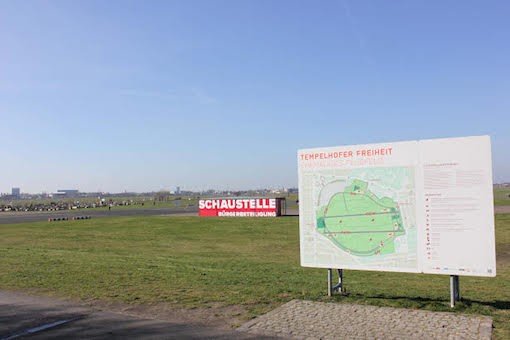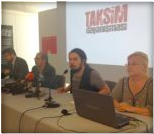Sitting in Engels—one among many of Neukölln's cosy, candlelit, hipster-friendly cafés—I read on a sticker the slogan: “Tah[r]ir, Taksim, Tempelhof: Das Feld gehört uns allen!” (Tahrir, Taksim, Tempelhof: The Field belongs to us all!). Tempelhof itself is a former airport located in former West Berlin, famous for its mythological role in the Berlin airlift during the Cold War. The airport was closed in 2008, but its vast runways and grass fields were re-opened to the public in 2010. People have adopted these as a space for outdoor sports, from kiting to cycling, while some skateboarders make best use of Tempelhof’s almost perfectly flat runways by attaching wind surf sails to their boards.
Indeed, the field provides the basis for re-workings of the relations between the material and the social, as exemplified by local urban ecological initiatives. The Stadtteilgarten Schillerkiez, for instance, consists of benches for humans, and beds for fruit and vegetables, each built predominantly from recycled materials. Tempelhof is also a site of further ecological significance, especially recognised as a significant home to a number of bee and bird species, including a local population of skylarks. Above all, Tempelhof provides a space for the city and its inhabitants to breathe.
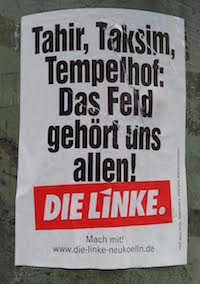
Today, the future of Tempelhof is subject to uncertainty and contestation. “Tempelhofer Freiheit” (Tempelhof Freedom) consists of plans to develop the area around the runways into residential areas, with a grammar school planned to provide new schooling opportunities to Schillerkiez (an adjacent neighbourhood), and a new S-Bahn station on the southern edge expected to improve connections to other parts of the city. Plans have also evolved to develop the airport building into a cultural centre, intended to rival Paris' Centre Pompidou. Meanwhile, the “100% Tempelhofer Feld” initiative, a coalition of community-based networks of activists and supporters, leads the call for greater citizen participation in the planning process. Among their demands are the preservation of the field, and the withdrawal of current plans for redevelopment. A petition calling for a local municipal referendum on the plans, requiring 173,000 signatures (seven percent of the local electorate), was successful. The final vote will take place on 25 May 2014.
The “Tahrir, Taksim, Tempelhof” sticker itself was produced by the local Neukölln branch of Die Linke (The Left), a political party founded in 2007, as a merger of the successor to the former East German ruling party (the SED), and a breakaway from the Social Democratic Party (SPD). The sticker’s appeal to various currents, and sites of resistance to global capitalism resonates with a current strand in Marxist political thought, namely connecting urban struggles through their reference to apparently global processes, such as the commodification of social life, the privatisation of public space, and a lack of transparency or public participation at some level of the political or planning process. Slavoj Žižek, for instance, has drawn parallels between the political and economic emancipatory struggles in Greece and Turkey, and argued in favour of global networks of activists to tackle problems that were not, he argued, in their essence local. Noam Chomsky, meanwhile, has suggested that Gezi Park is “at the forefront of a worldwide struggle to reclaim the global commons.” “Tahrir, Taksim, Tempelhof” picks up where these analyses have left off.
“Tahrir, Taksim, Tempelhof” can be taken, therefore, as a provocation to rethink the similarities and differences as well as the connections between these sites, one located in Europe, another in the Middle East, and a third bridging the two. In Istanbul and Berlin, debates around gentrification, the cosmopolitan or “global” identity of the city, the built environment, urban ecology, and the future prospects of migrant or minority communities are among some of the obvious commonalities. But, what can we learn from this linkage, or from a closer comparison between these sites, and the emergent fields of contentious politics they have generated?
Tahrir: A Square Too Far?
In early 2011, diverse political currents assembled in Cairo's Tahrir Square, lead to the capitulation of Hosni Mubarak, after thirty years of ruling Egypt. Since then, during waves of upheaval against the Supreme Council of the Armed Forces (SCAF) and Mohammed Morsi regimes respectively, Tahrir has provided a locus for protesters to gather. Historically, the legacy of Anwar Sadat's infitah (opening up) has included the privatisation of space (for instance in the expansion of the number of gated communities), attempts to minimize trade union activism, and the heightening of security measures on the basis of Islamist threats. These were all factors that shaped the events of 2011 and since. The initial anti-government protests were connected to sustained governmental attempts to discipline the population, such as violent police interventions into the popular quarters of cities, the labelling of supposed non-conformists as baltagiyya (thugs), and the omnipresence of Mubarak's gaze from billboards. It is not surprising, then, that contesting public space has become central to a counter-politics in Egypt.[1]
As protests began in Istanbul’s Gezi Park in May 2013, comparisons were frequently drawn between Turkey and the earlier events in Egypt—some even labelled Gezi Park “Turkish Spring.” Yet, in making this connection, commentators failed to recognise the specificity of these sites. For many protesters in Istanbul, the significance of Gezi Park and Taksim Square themselves was central to their participation in the initial wave of protests and occupation. For example, environmentalist activists claimed that the Taksim Project threatened to destroy one of central Istanbul's last remaining green spaces. For Kemalists, the importance of Taksim Square to Atatürk's secularist legacy has not been lost over time. Trade unionists, socialists and even Anti-Capitalist Muslims can recall the importance of Taksim as a site of past struggles, for example at May Day demonstrations. Meanwhile, the Armenian group Nor Zartonk drew attention to the presence of an Armenian cemetery that had stood there for centuries before Gezi Park. Like Tempelhof, Taksim and Gezi were contested partly in reaction plans for their redevelopment. At least initially, the same cannot be said of Tahrir Square. What can we deduce from Die Linke’s linkage, then, beyond broad comparisons about widening economic inequality, and the place of public space within a counter-politics?
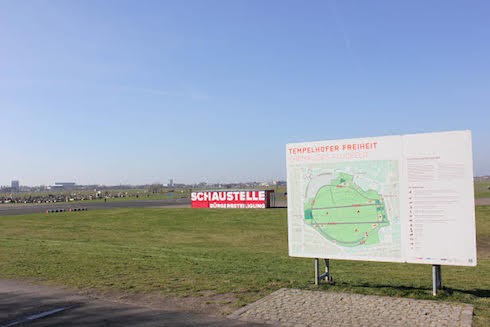
[Tempelhofer Park. Image by author.]
Translating 'Das Feld'
The protests in Istanbul multiplied across other cities in Turkey, picking up on wider anger about police violence, corruption and a general lack of accountability, often attributed to Erdoğan’s majoritarian style of rule. Similarly, the message in Tahrir reverberated across Egypt, while the “Arab Spring” prompted further questions about the resonances between multiple sites of protest across the Middle East. The question of how political actions can spread both nationally and internationally, raised by the Arab Spring, and subsequently by protests across Turkey, returns us to the Die Linke sticker, which draws linkages between a number of struggles globally, perhaps intending for these to be seen as resistance to the same global forces.
But the caption “das Feld” (the field) could itself be interpreted, or indeed translated, differently: rather than refer to the actual physical spaces it mentions, it could refer to something more like the context, or political field, in which localized forms of political practice become possible and significant. This suggests the possibility of a comparative analysis of these complex and shifting political fields. For example, in Turkey, the history of Gezi Park generated the political field in which political action became meaningful to Kemalists, Anti-Capitalist Muslims, and Nor Zartonk, albeit in different ways. Moreover, each political grouping came with its own set of grievances, and memories of past struggles, but in turn learnt about and from one another. Football fans, subject to a history of police violence, used their experience to help other protesters deal with life on the front line, for example when faced with tear gas. LGBT and feminist activists made connections between Gezi and wider issues of discrimination and gender stereotyping in Turkey. Indeed, sociologist Zeynep Tufekci recordedhow some football fans had initially chanted “Faggot Tayyip,” and LGBT activists challenged them to relieve their chants of homophobic language. Later, they chanted “Erdoğan is a sexist.”
Furthermore, the professional expertise of dissident lawyers, urban ecologists, archaeologists, engineers and architects was central to challenges to plans to redevelop Gezi and Taksim. For example, archaeologists drew attention to improper practice during the planning process, noting that there had been a lack of excavation.Archaeologist Sam Hardy has suggested that the absence of archaeologists employed by the municipal government on this occasion may have had something to do with the embarrassment that would have been caused to the government had the presence of the Armenian cemetery been made public. The Chamber of Architects and Engineers (TMMOB), meanwhile, were a central force in bringing a court injunction against the Ministry of Culture and Tourism in June 2013, in order to halt the Taksim Project.
Returning to Cairo, the film “Al-Midan” (The Square, 2013) has illustrated how over the course of numerous occupations of and struggles over Tahrir during the past three years, the square itself has both engendered various forms of contentious practice, and itself been contested by a range of actors. Egypt’s secular youth and Muslims Brothers were each able to channel their political marginalisation, and feelings of disempowerment through their occupation of the square, sometimes in conflict with one another. Ultras football fans, secular activists, artists and musicians filled the square with their banners, graffiti, songs and chants. Muslim Brothers, meanwhile, conducted mass prayers in the square. As such, the square emerged for each as central to a politics of spectacle, and of challenging established power. Recognizing the politicisation of Tahrir as at once an arena for specific demands, and a symbol of broader political frustration with the status quo, SCAF attempted to restrict the presence of potentially subversive political actors in the square. The military beautified the square following in one such crude attempt to depoliticize it, re-growing grass that had died, while telling protesters to go home.
One of the most moving and striking aspects of “Al-Midan” is how it captures the complex relationship between secular activists, and Muslim Brothers. On several occasions, for instance during attempts by Muslim Brothers to assemble their own critical mass in the square, the close friendships made during previous occupations are put into question by political differences or past affiliations. As such, the recent history of Tahrir has transformed the way in which it is relevant to politics for a range of actors, above all in complex negotiations around the variegated politics of difference in Egypt.
In general, Taksim and Tahrir’s multi-textured histories, both recent and distant, as well as that of the Turkish and Egyptian states respectively, have come to shape the kinds of practice that are relevant to an emancipatory politics, and in turn give meaning to them. Returning to Berlin, the peculiar mix of skateboarders, community ecologists, local activists, migrant communities, Die Linke, trendy cafés, and even the species of flora and fauna inhabiting the meadows has emerged in relation to the specific histories of the German state, Berlin, and Tempelhof. Each has its part to play in Tempelhof’s future.
A Field of Comparative Politics
During the Cold War, areas close to the Wall in West Berlin such as Kreuzberg and Neukölln were unattractive to well-off residents, and were inhabited by an influx of migrants from Turkey and the Middle East. Since the Wall fell, low rents and cost-of-living, by comparison to other the major cities in western Europe and the United States, have attracted a young, artistic diaspora from these countries. This is the backdrop to the current debate around Tempelhof's future. Despite controls, rent prices and demand for housing are moving upwards. But who, ask the supporters of “100% Tempelhofer Feld,” will be the beneficiaries of new, high-class apartments around the old runways, and a cultural centre likely to attract the attention of the city, if not the world?
This aspect is reminiscent of the Taksim Project, which targeted Taksim and Gezi as sites for urban renewal. The former was to undergo a pedestrianization project, while the latter was to be replaced by a shopping mall in the design of Ottoman barracks, which had formerly stood on the same site. In recent times, Istanbul’s inner city areas have been targeted as “derelict” or “obsolete,” and subject to renewal projects. Their populations—often including ethnic, racial and religious minorities—are forcibly removed,[2] while in their place there has been a proliferation of hotels, malls, and tourist attractions.
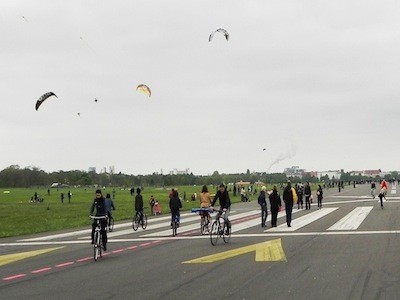
[Part of Tempelhofer Feld with the Stadtteilgarten Schillerkeiz (left of frame). Image by author.]
However, the differences between Tempelhof and Taksim are also made apparent by a focus on history and practice. While Turkey still struggles to reconcile present disputes about the democratic process with its past—military rule and intervention into government, tensions between secularism and political Islam, and exclusionary politics with respect to ethno-religious minorities—the use of a petition demanding a referendum in Berlin illustrates residents’ faith in at least some of the instruments of “direct democracy.” These more conventional democratic methods are quite different from the techniques used to challenge established power in Egypt and Turkey, which revolved around openly occupying public space and, in the latter case, legal challenges to the planning process.
For those of us concerned with urban struggles across the Middle East, Europe and around the world, where people seek to reclaim public space, and to foster an emancipatory politics, we could do worse than to focus on these historically complex and localised fields of political practice. In cases such as Turkey and Egypt, this means recognising that the struggles in Taksim and Tahrir had wider national and even, as Die Linke’s slogan attests to, transnational resonances. However, it also requires us to recognize how these sites articulate specific types of demands, often relating to the urban settings in which they are situated. The artists of Tahrir, the archaeologists of Taksim, and the allotment growers of Tempelhof are historically situated, and we should refrain from imagining their politics as necessarily part of the same project. While Die Linke’s slogan directs us to some similarities between recent political events in Istanbul, Cairo and Berlin, we must avoid the kind of reductive message that constantly reminds us “this is happening everywhere.” Conversely, “Tahrir, Taksim, Templehof: Das Feld gehört uns allen!” can be usefully read as offering a comparative mode of analysis that draws attention to differences in the political fields that both constitute and emerge anew from these three spaces.
-----------------------------------------
[1] On the history of trade union activism, see for instance Joel Beinin, “A Workers’ Social Movement on the Margin of the Global Neoliberal Order, Egypt 2004-2009,” in Social Movements, Mobilization, and Contestation in the Middle East and North Africa, edited by Joel Beinin & Frédéric Vairel (Stanford: Stanford University Press, 2011): 181-201. On the 1990s real estate market, see Timothy Mitchell, “Dreamland: The Neoliberalism of your Desires,” Middle East Report 29, no.1 (1991), 28-33. On policing in popular quarters, see Salwa Ismail, ”The Egyptian Revolution against the Police,” Social Research: An International Quarterly 79, no. 2 (2012), 435-62. On ‘baltagiyya’, see Farha Ghannam, “Meanings and Feelings: Local Interpretations of the Use of Violence in the Egyptian Revolution,” American Ethnologist 39, no.1 (2012) 32-36. On image politics, see Lina el-Khatib, Image Politics in the Middle East: The Role of the Visual in Political Struggle (London: IB Tauris, 2012).
[2] See, for example, T. Kuyucu & Ö. Ünsal, “‘Urban Transformation’ as State-Led Property Transfer: An Analysis of Two Cases of Urban Renewal in Istanbul,” Urban Studies 47, no. 7 (2010), 1479-99.




